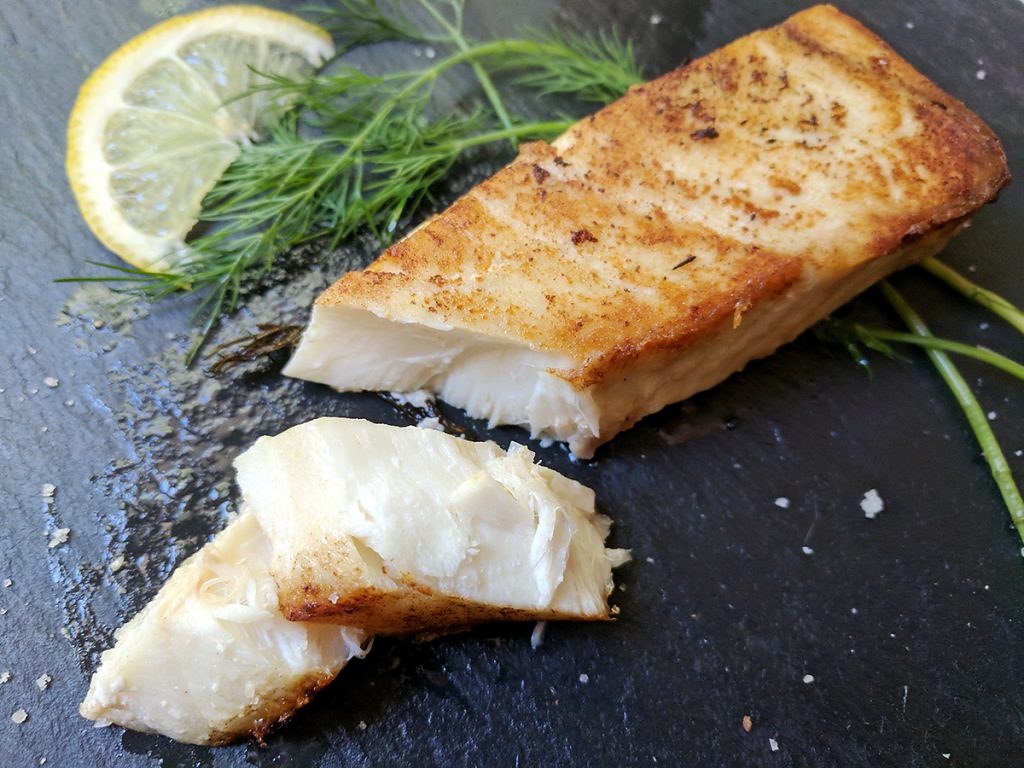Wild halibut is a well-loved type of seafood. These are the largest flatfish in the world, reaching up to 8 feet in length and 500 pounds in weight. They can live upwards of 50 years, and they’re pretty funny looking, to boot. That said, halibut eaters will be pleased to know that they are rife with nutrients, including selenium, niacin, phosphorus, magnesium, vitamin b12, and vitamin b6. Halibut also provides high-quality protein.
If you’re new to buying seafood online, you may not know all the benefits of wild-caught halibut. Similarly, knowing what to look for can be tough. We’ll walk you through what and how to buy halibut online.
Alaskan Halibut Fillets and Portions
| Company | Min. Order | Price/lb | Reviews | Rating | Website |
|---|---|---|---|---|---|
| Global Seafoods | 10 lbs | $28.50 | 1,130 | 4.6 | |
| Wulf’s Fish | 1 lb | $29.00 | 764 | 4.9 | |
| Sizzlefish | 3.5lbs | $39.70 | 341 | 4.9 | |
| Lummi Island Wild | .5 lbs | $41.00 | 21 | 4.8 | |
| Fulton Fish Market | .5 lb | $47.20 | 604 | 4.4 | |
| Seabear Smokehouse | 1.5 lb | $53.00 | 273 | 5.0 | |
| Vital Choice | 1.5 lbs | $54.66 | 23,132 | 4.8 | |
| Sea to Table | .6 lb | $51.00 | 2,784 | 4.7 |
The Benefits of Wild Fish
Some studies have shown wild halibut to be a heart-healthy food that helps the heart fight disease. Studies also show that halibut can help prevents inflammation. One half-fillet of halibut can satisfy nearly a third of the body’s nutritional needs, making this a great meal option.
Unfortunately, halibut is a slow-growing species that, like many fish, suffers from overfishing. Pacific wild-caught halibut are sustainably managed, but that doesn’t translate globally for halibut.
In order to curb the overfishing of wild fish populations, there are Atlantic halibut farms in Canada, Iceland, Norway, and the United Kingdom. Fish farming means that the fish are commercially raised in controlled pens in lakes, rivers, oceans or tanks. In the global fight against overfishing, the fishing industry’s response has largely leaned on fish farming to take pressure off of the oceans.
Wild-Caught vs. Farm-Raised Halibut
Oftentimes, wild-caught fish are assumed healthier because of their natural diets and a decreased exposure to potentially harmful substances. Farm-raised halibut are usually less expensive and more readily accessible for the consumer.
However, farmed fish’s crowded growing conditions can easily expose the halibut to bacteria, pesticides, and parasites. The fish farming industry has developed better, more healthier ways of farming, but these threats still exist. The likelihood of wild-caught fish contracting a harmful bacteria or parasite is much lower than that of a farmed halibut, though it is possible. Compared to another big-name fish, salmon, whose wild counterpart has better nutritional content than farmed, the difference in nutritional content between wild halibut and farmed halibut is not enough to influence the consumer’s choice.
There are several initiatives designed to alleviate strain on the halibut industry. Direct Seafoods began a campaign in 2019 geared toward getting restaurants to use farmed halibut instead of Atlantic wild-caught halibut. The campaign is aimed at Atlantic halibut because of its suffering populations. On the other hand, Pacific halibut is actually sustainably managed throughout the United States and Canada.
Does Halibut Sourcing Location Matter?
The distinction between Atlantic and Pacific isn’t always clear and can affect how information, like Direct Seafoods’ campaign, trickles down. Atlantic halibut is not as sustainably managed, and campaigns like these put pressure on the fishing industry to figure out a management plan, or buyers will pivot to farmed halibut. Will that translate into pressure on the Pacific wild halibut fishing industry due to misinformation? It’s possible. Due to threats of overfishing and trends of management, it is most responsible from a sustainability perspective to choose from farm-raised Atlantic halibut or Pacific wild halibut.
Moving the lens closer to home, most halibut in the United States market are wild-caught. The University of Maine’s Center for Cooperative Aquaculture Research has deemed Atlantic halibut as one of the best candidates for aquaculture, or fish farming, in Maine. In fact, the CCAR has already created the basis for an Atlantic halibut farming industry through the development of hatchery, technology, and facilities that will ultimately grow farmed halibut to harvest weight. The CCAR does not have any current industry partners, but they do supply Canadian companies with juveniles, as well as parties interested in getting involved with halibut farming. Due to its Atlantic access, the University of Maine could lead the United States in halibut farming if and when the domestic industry trends that way.
Take note of our Affiliate Relationships that may exist with this page and companies listed on it.


